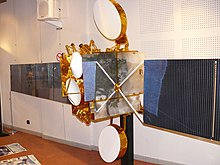Hispasat 1D
| Names | Hispasat 1D |
|---|---|
| Operator | Hispasat |
| COSPAR ID | 2002-044A |
| SATCAT no. | 27528 |
| Spacecraft properties | |
| Bus | Spacebus-3000B2 |
| Manufacturer | Alcatel Space |
| Launch mass | 3,250 kg |
| Dry mass | 1,345 kg |
| Start of mission | |
| Launch date | 18/09/2002 |
| Rocket | Atlas IIAS |
| Launch site | Air Force Eastern Test Range (AFETR) |
| Orbital parameters | |
| Semi-major axis | 42,164 km |
| Periapsis altitude | 35,773.9 km |
| Apoapsis altitude | 35,813.6 km |
| Inclination | 2.5° |
| Period | 1,436.1 minutes |
The Hispasat 1D, since 2016 called Hispasat 30W-4 is a Spanish communications satellite launched in 2002 operated by Hispasat. Together with the Hispasat 1C it formed a constellation in order to strengthen communication ties between the American continent (particularly South America) and the Iberian Peninsula for both governmental and private uses.[1][2][3][4][5][6][7][8]
The end of the service life of the constellation was scheduled for 2017 (after more than 15 years in active)[9] however as of 2022 the Hispasat 1D is still active.[10][11][12]
Body[edit]

The Hispasat 1D was built by Alcatel Space. It is based in the Spacebus-3000B2 bus. The satellite has a dry mass of 1,345 kg (increased to 3,250 kg at launch). It is shaped as a rectangular prism whose lateral faces allocate four Silicon retractable solar panels capable of providing 7 kW (end of life) directly to the two sets of regulated power supplies.[13] When fully deployed it has a RCS of 17.6011 m2.
The satellite is 3-axis stabilized thanks to a set of 4 FDIR reaction wheels.
Propulsion[edit]
The main propulsion for the satellite is provided by a liquid propelled S400-12 rocket engine.[14] It was developed by ArianeGroup (former Airbus DS). It uses monomethylhydrazine and mixed oxides of nitrogen as fuel. It develops a thrust between 340 N and 440 N.[15][16]
Additionally, the satellite also contains 14 secondary bipropellant S10-18 engines for ABM and aspect control. They use Dinitrogen tetroxide and monomethylhydrazine and are capable of developing up t0 10N of thrust.[17]
The fuel is allocated on two independent OST 22/4 surface-tension fuel tanks.[18]
Communications module[edit]
The satellite is equipped with three antennas, 28 Ku-band transponders and several X-band transponders. It is intended to strengthen communications between the American continent Spain for government, commercial and military use. Particularly offering TV coverage from international channels to South America.
Launch[edit]

The satellite was launched the 18th of September 2002 at 18:00 on board an Atlas IIAS rocket from Space Launch Complex 36A in Cape Canaveral Space Force Station under the direction of Space Launch Delta 45.[19][20] It was successfully put into a geostationary orbit 30º W with an apogee of 35,813.6 km, a perigee of 35,773.9 km, a semi-major axis of 42,164 km, an inclination of 2.5º and an orbital period of 1,436.1 minutes.[21]
During its service life it is being monitored from Hispasat's Satellite Control Centre in Arganda del Rey (Madrid).[22]
References[edit]
- ^ "Hispasat 1C → Hispasat 84W-1, 1D → Hispasat 30W-4 → Hispasat 143W-1 → Hispasat 136W-1". Gunter's Space Page. Retrieved 2022-01-25.
- ^ "Europe Coverage: Hispasat 1D/1E". www.kvh.com. Retrieved 2022-01-25.
- ^ AC-159: Hispasat 1D launch (18.09.02), retrieved 2022-01-25
- ^ "Hispasat 30W-4". www.hispasat.com (in Spanish). Retrieved 2022-01-25.
- ^ "Hispasat-series (and other Spanish communications satellites)". rammb.cira.colostate.edu. Retrieved 2022-01-25.
- ^ "Satbeams - World Of Satellites at your fingertips". Satbeams Web and Mobile. Retrieved 2022-01-28.
- ^ "Hispasat-30W-4 autorizado en Argentina". Latam Satelital (in Spanish). 2017-02-03. Retrieved 2022-01-28.
- ^ Lima, Richard (2016-03-16). "SatÉlites Hispasat 30W mudaram de nome... e outros da Hispasat tambÉm". GPS.Pezquiza.com (in Brazilian Portuguese). Retrieved 2022-01-28.
- ^ "Hispasat 1C fulfilled its mission and was sent to the graveyard orbit". Thales Group. Retrieved 2022-01-31.
- ^ "Television channels on satellites Hispasat 30W-4 (1D), Hispasat 30W-5 (1E) & Hispasat 30W-6 (new) [30°W]". SatExpat.
- ^ "Europe Coverage: Hispasat 1D/1E". www.kvh.com. Retrieved 2022-01-28.
- ^ "Hispasat 1D – internet satelital idirect". conexionporsatelite.com. Retrieved 2022-01-31.
- ^ "Aerospatiale → Alcatel Space → Alcatel Alenia Space → Thales Alenia Space: Spacebus-3000/4000 B-Class". space.skyrocket.de. Retrieved 2022-02-02.
- ^ "Hispasat 1D / 2002 - 044A". www.space-propulsion.com. Retrieved 2022-01-31.
- ^ "400 N Bipropellant Apogee Motors". www.space-propulsion.com. Retrieved 2022-01-27.
- ^ Kozlov, Alexander A.; Vorobiev, Aleksey G.; Borovik, Igor N.; Kazennov, Ivan S.; Lahin, Anton V.; Bogachev, Eugenie A.; Timofeev, Anatoly N. Cuppolett, Dr. John (ed.). Development Liquid Rocket Engine of Small Thrust With Combustion Chamber from Carbon - Ceramic Composite Material (PDF). InTech. p. 5. ISBN 978-953-307-351-4.
{{cite book}}:|website=ignored (help) - ^ Krishnan, Subramaniam; B Muhalim, Noor Muhammad Feizal. "Design of Nitrogen-Tetroxide / Monomethyl-Hydrazine Thruster for Upper Stage Application" (PDF). Propulsion Krishnan.
- ^ Cortés Borgmeyer, Susana. "Surface Tension Propellant Tank OST 22/X" (PDF). Space Propulsion. ArianeGroup - Orbital Propulsion.
- ^ "NASA - NSSDCA - Spacecraft - Telemetry Details". nssdc.gsfc.nasa.gov. Retrieved 2022-01-31.
- ^ "Hispasat 1D (Atlas 2AS)". www.lunarcabin.com. Retrieved 2022-01-25.
- ^ "Technical details for satellite HISPASAT 1D". N2YO.com - Real Time Satellite Tracking and Predictions. Retrieved 2022-01-25.
- ^ "Hispasat improves the energy efficiency of its satellite control centre in Madrid and reduces its ecological footprint". www.hispasat.com (in Spanish). Hispasat press release. 2019. Retrieved 2022-01-29.
